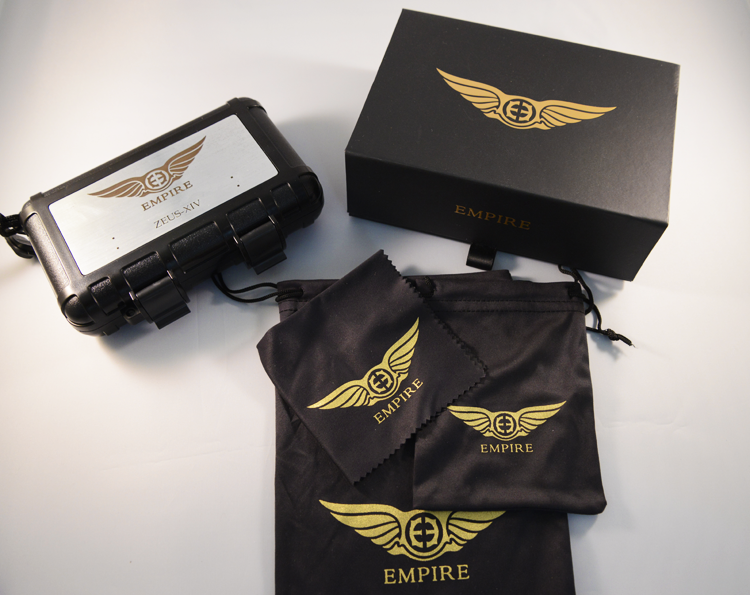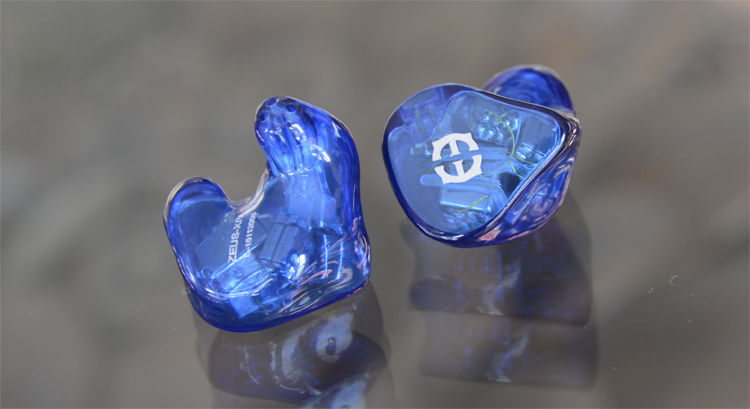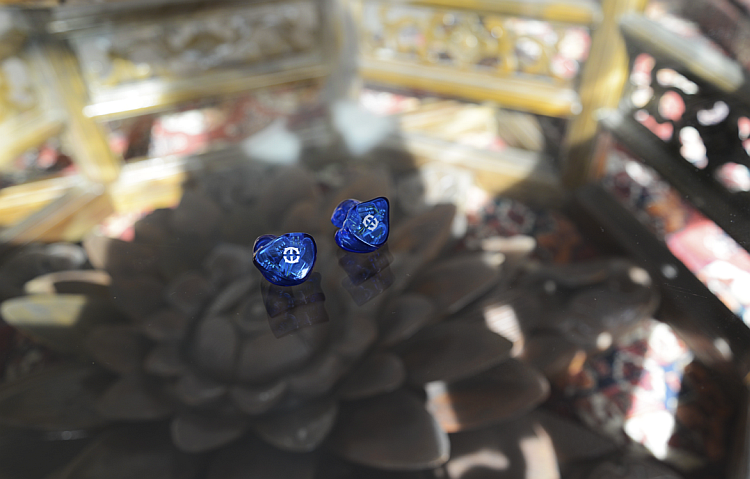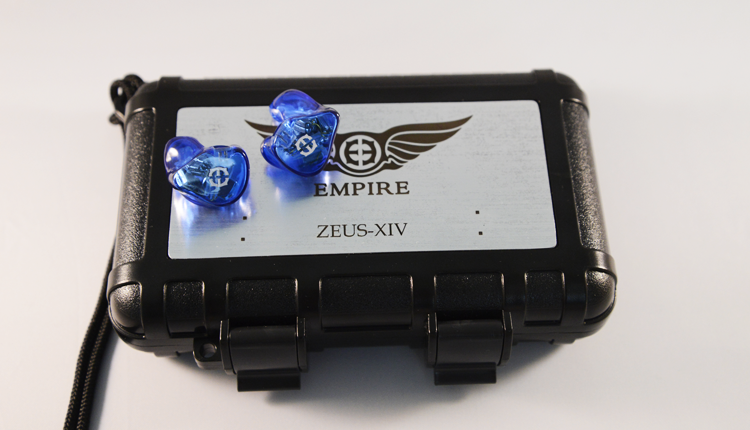The Empire Ears Zeus is the flagship custom monitor from the Georgian-based US company. It contains no less than 14 balanced armature drivers and is priced at $2099.
Disclaimer: The Empire Ears Zeus was sent to us in exchange for our honest opinion in this review. Many thanks to Empire Ears for giving us this opportunity.
You can read about previous Empire Ears products reviewed on Headfonics here.
A few years back EarWerkz was a blossoming company, making a name with models such as the Supra and Legend R/Omega. But its founder Jack Vang soon hit a glass wall, as his ambition reached beyond the constraints of his current organizational possibilities.
The customer service was struggling to keep up, and the desired lead time was under attack. Founding a solid company wasn’t enough – Jack wanted to rule an empire. So to realize its full potential, Jack construed the merger of Earwerkz with Savvitek, an industry-leading engineering, and manufacturing company.
EarWerkz was reborn into Empire Ears, and thus it began. The ambition in its name resonated in the model line up, named after the ancient Greek gods. But it didn’t end there, as Empire Ears kept the community in suspense for their grand revealing: the world’s first monitor with 14 BA drivers.
Ever since companies started implementing more than 3 or 4 drivers in their designs, the question was raised whether more drivers and crossovers resulted in better sound. Iems as the SE846 and UERM had proven how far you could get with 4 drivers, and the Spiral Ears 5-way Ultimate is still considered the one to beat with its 5 BA drivers.
And sure, there are plenty iems with 8-12 drivers that just don’t seem to get the tuning right. However, in this case – spoiler alert – more is better, in true form of the American spirit. Zeus lives up to its expectation, and not in the last place, its price.
Accessories
Empire Ears takes a lot of pride in their presentation – it’s clear the unboxing experience was designed to resonate with class belonging to a high fidelity product. Zeus is delivered in a matte black box with golden Empire Ears logo, with a top that flips over backwards twice.
The box contains a large S3 carrying case, layered with sturdy foam for protection. It contains a large microfiber pouch to protect the case, a smaller size pouch for just the monitor, and a nice cleaning cloth – all with the golden Empire Ears logo.
The rest of the lineup comes with silver logos – a nice touch to differentiate Zeus as flagship. The only other accessory is a cleaning tool, but let’s face it, this is a custom – it’s the only accessory you’ll ever need. Overall, it’s a high-class package with attention to detail.
Cable
Both Zeus and Apollo come with a BTG Starlight SPC upgrade cable: a white 4-braid terminated in a right angle jack. The BTG cable is a nice touch and looks and feels better than generic factory cables monitors usually come with, although it doesn’t have the quality feel a high tier upgrade cable.
But then again, those usually sell for (at least) multiple times the price. I’ve tried multiple (silver) cables with Zeus but came back to the BTG Starlight. I find it is more than adequate and doesn’t form a constraint on its tone or resolution.
Design
Zeus consists of 3 clusters of 4 very small drivers for the mids and treble around 2 big bass drivers, and because of the use of smaller drivers, it remains within proportion for a multi BA TOTL. It’s smaller than the JH Siren Series or Rhapsodio Solar with 10 drivers for instance; because of the Solar’s 4 large mid drivers, it takes up more space requiring a larger housing.
Due to the design choice with 12 smaller drivers the custom Zeus still has quite an average size, and I don’t think people with small ears need worry that it won’t fit (I have small ears myself). The only possible issue might be that the 4 bores take up a bit more space in the canal, but this is also well within proportion.
The finish reveals quality; a smooth surface without bubbles or imperfections. Mine is a clear blue, with the transparent faceplate and body representing the house design of the Empire Ears and EarWerkz before that.
It gives Zeus both a high tech and classy look, and I chose it because I felt it represented the Empire Ear’s design. For those wanting something else, Empire Ears offers various other materials such as carbon, wood, or abalone as extra options.
Fit & Isolation
Both Zeus and Apollo came from the same mold, and fit me perfectly – snug, but mainly comfortable. As my ears are on the smaller side, the Solar’s bigger 10 BA drivers were a bit tight for me at first; not the case with Zeus. It seems like there’s space left to fit in a few more – with a check behind the first 14 BA drivers, who’s to say they’ll stop at 14.
Insertion is smooth, and background noise is reduced to a minimum. Despite its four bores, the nozzle isn’t wider than usual, and it has an average depth. While it doesn’t sit completely flush within the ear, it doesn’t protrude as much as you might expect from its driver configuration.
Sound Impressions
Summary
Zeus has a forward presentation with a mid-centric signature: slightly enhanced bass and a very full midrange topped off with refined treble with more than adequate sparkle to satisfy. The presentation is upfront and stimulating – there’s nothing laidback here.
Notes are bold, and Zeus displays good ability to recreate both thin and thick notes when necessary; acoustics and string instruments sound clear and refined, while electric guitars sound full and engaging.
Tone onset has an accurate articulation – smooth and fast, and when properly driven Zeus displays excellent dynamics. The combination of its forward center midrange and high resolution creates a clear center image while accentuating subtle effects of echo and reverberation – making them more present while contributing to that sense of standing in a great hall.
This resolving nature brings detail to the foreground, without having an analytical or bright tone. This reflects quality, as it is technically more challenging than simply ‘turning the light up’.
The soundstage is about average in width, but both tall and deep. It wouldn’t suffice to say imaging is excellent, for it has a precision and 3D feel that reflects an incredible degree of technical engineering.
Instrument position is incredibly precise in the different layers spreading along the width and depth of the field, and together with the exceptionally high resolution provides a clear image of the instruments in space. Zeus inherently has a clean background and is highly transparent; although the warmth in the atmosphere is highly sensitive to the source, and can vary accordingly.
Bass
Zeus’ bass is slightly north from neutral. With bass-heavy music it is powerful, and slams with the authority one can expect from its name. Bass speed is about average, but has great detail and texture; multiple bass lines are displayed with great precision and separation.
The sub-bass hits very deep, providing great depth in the soundstage. The mid-bass provides a good slam, while also giving fullness to the lower mids. The general tone is slightly warm.
Midrange
The lower midrange gives great size and power to the presentation. Rock ‘n roll guitars sound big and engaging; a leaner iem will miss that lower end extension, resulting in a relatively smaller size and different tonality. But where this midrange impresses most and truly is one of the highlights of listening to Zeus, is vocals.
Zeus is in its element with heartfelt songs like Chris Isaak’s “Wicked Game”, the Righteous Brother’s “Unchained Melody” or R.E.M’s “Everybody Hurts”. As much as I hate to admit it, Adele is no slouch either – you can feel the heartbreak is sincere; not only by the lyrics but the emotion behind the vocal.
To tap into that pain, the anguish; the sound must come from deep – very deep. Zeus’ midrange provides exactly that: warm, full, and clear, making vocals sound incredibly deep and powerful while adding a certain calmness and confidence to the singer’s presentation.
But for the ultimate experience you need to go one level higher: singers like Andrea Bocelli – that’s where the magic happens. The forward-center and upper mids combined with the high resolution captivates with a crystallized image of his performance: sound is being produced from deep within the chest – you can feel the air being released from the lungs.
Subtle dynamic changes in his voice are accurately displayed: you can see the position of his mouth affecting the quantity and tone of the sound being produced. When opera singers like Bocelli perform, you can feel the effortless production of a high volume of sound, the ample power in reserve. A surplus of power, mirrored by Zeus’ technical ability and midrange.
Treble
I’d say there is a slight dip in the lower treble; while there’s enough air and space between the instruments, Zeus doesn’t have a particularly sparkly sound overall. This also means it’s spared from almost all sibilance unless it’s present in the recording.
Its extension through the mid and higher treble is excellent; Zeus resonates with great transparency while remaining very controlled and non-fatiguing in longer sessions due to the linearity. Articulation and decay are quick and precise. All in all, very refined. A gentleman’s treble – without sounding dull.
Select Comparisons
Perfect Seal AR6
$950
At less than half the price and less than half the drivers (6), the AR6 might seem out of place here. But because of a very different signature, the AR6 demonstrates the effect of design concerning signature, and its relation to the soundstage.
The AR6’ bass is linear, and relatively neutral compared to the bass of Zeus. The mid-bass is leaner and creates a very spacious presentation. Not to say the midrange is recessed – the lower midrange just doesn’t get the fill from a more prominent mid-bass like Zeus. A lift in the upper midrange gives the AR6 a pleasant tonality, but Zeus has a much fuller sound; instruments are bigger and have more power, while vocals sound deeper.
But because the AR6 lacks lower midrange presence in combination with a lift in the lower treble, its soundstage is noticeably larger and airier; instruments fan out further in all directions, both in width and depth. The smaller midrange size makes them sound further in distance, similar to like an object in the distance is visually smaller.
Soundstage
Zeus’ soundstage, however, is taller. The thick and full Zeus sounds like standing in a massive hall; with the AR6 you take a step outside to catch some air. The AR6’ treble is more forward, but also less controlled and can sound a bit splashy in comparison. Zeus not only sounds a lot fuller throughout the range, but its treble is also smoother and more refined.
The AR6 was specifically designed for its soundstage. Because of the clean mid-bass and distant lower mids, the size of the soundstage is vast and airy. Instruments have good focus and separation. But Zeus’ bold presentation gives the midrange power and size; notes carry more weight, while also being a great deal smoother. The AR6 has great separation of instruments due to its airiness and soundstage; Zeus impresses with its smooth presentation built on resolution and imaging.
EarSonics S-EM9
$1490
EarSonics is a French company with their own house sound; a focus on musicality and enjoyment, a very recognizable and audible signature that is present throughout their lineup. Their iems are forgiving, engaging, and emotive.
EarSonics recently released a new flagship: the universal S-EM9 with a 3-way crossover design and 9 BA drivers. And with the S-EM9, they didn’t stray far from that philosophy.
The S-EM9 is fast and precise. The attack is razor-sharp and decay is quick, providing a great sense of pace. Both share great bass that is slightly enhanced. While they both have powerful sub-bass slam, Zeus hits with more authority due to its relatively enhanced mid-bass, while also having a more forward lower midrange.
Compared to Zeus, the S-EM9’s treble is more forward and energetic, while still remaining controlled and smooth – a remarkable feat. The S-EM9 begs you to turn the volume higher and higher. High hats are slightly more pronounced, and dictate the sense of rhythm.
The S-EM9 is first and foremost engaging: the fast attack and decay, along with the energetic treble gets your toe tapping the moment the music speeds up – an absolute delight for fast-paced electronic music or rock. But the roles are very different for guitar-based music and vocals, due to Zeus’ mid-forward signature.
The midrange sounds full and powerful, and its performance here overshadows the S-EM9. The S-EM9’s mid-bass doesn’t give as much size to the lower midrange, affecting the size and depth of, especially male vocals.
As the upper midrange is more accentuated our friend Bocelli’s voice is now coming from the throat and mouth; the perception of ‘chest’ is far less tangible. While the S-EM9 has more sparkle and treble energy, Zeus has more size and power in the midrange: a calm but confident presentation.
Soundstage
The S-EM9’s soundstage is slightly more intimate but has good proportions in width, height, and depth. Zeus’ soundstage, however, is larger in all directions. Both the S-EM9 and Zeus share excellent technical capabilities: precision in location and timing.
Similar to Zeus, the S-EM9 has precise imaging evenly diffused in all directions, although Zeus presents a higher quality of layering. While the localization of instruments is similar, Zeus’ resolution is slightly higher, resulting in greater midrange transparency and instrument definition. But the S-EM9 doesn’t stray far behind and demonstrates significantly above average capability.
Rhapsodio Solar
$1550
Rhapsodio made their entrance in top of the line territory with their first 10 BA driver monitor: the Solar, a warm and smooth operator with thick notes and powerful bass slam. Like Zeus, the Solar shares punchy sub-bass that can hit with authority when called upon, although Zeus’ has better extension and can hit deeper.
Low-end
Both share excellent lower frequency resolution, although I’d give the edge to Zeus. The Solar’s mid-bass, however, is more enhanced, giving good size and especially warmth to the midrange; overall the Solar has a warmer atmosphere, which also gives it thicker notes compared to Zeus.
The Solar excels with electric guitars, sounding full and powerful. Put on some Guns ‘n Roses, and the Solar is in its element. The guitars demand their place in the presentation and refuse to take a step back to the vocals.
Due to the boosted lower midrange, male vocals sound clear and full, but they do not have the depth and density of Zeus – this is Zeus’ territory, due to its forward center mids. In addition, Zeus’ upper midrange is also more forward bringing out more emotion and intimacy with vocals.
Mids
The Solar’s midrange is more laidback in comparison, with thicker and warmer notes due to its warmer mid-bass. Zeus demonstrates better ability in creating thin and thicker notes, which gives it the advantage for acoustics.
Treble
The roles reverse again for the lower treble; the Solar’s significant peak here gives it a more spacious sound, although it is still less airy due to the warmer mid-bass presentation. But Zeus catches up, and starts to trump the Solar on technical ability; better presence in the mid-treble area contributes to Zeus’s greater transparency – acoustics and string instruments not only have a clearer, more realistic tone but also more sparkle. Finally, Zeus has better treble extension; contributing to a significantly better resolution, especially in the midrange.
Both have an average to slightly above average soundstage width. The Solar has good soundstage depth and excellent imaging, but Zeus adds a higher resolution and better layering. The Solar has a great sense of detail, which can be attributed to the lift in the upper midrange and treble. Zeus presents detail from its resolving nature, the high resolution, and precise imaging.
Synergy
Zeus is very transparent to the source, as it doesn’t utilize any dampers, resistors or filters to manipulate the frequencies and its signature will vary accordingly; most ciems will significantly improve with better source, but nothing to the extent of Zeus – at least from my experience. It goes without saying that a $2099 ciem should be driven by a quality dap.
For the sake of this review, I stuck Zeus in an iPod; Zeus did not appreciate it and made me promise to never be subjected to that again. Gone was the resolution, precise imaging, and 3D stage. But once connected to a certain quality, playing around with different sources can feel like listening with different iems.
Different DAPs always have their own characteristics, but Zeus amplifies them with a magnifying glass. Moreover, every step up in quality is linearly reflected in Zeus’ capability.
Since Zeus is very sensitive, there have been numerous reports of extensive hiss. Especially the Lotoo Paw Gold seems to give some issues, while others also mentioned the Mojo. None of my sources gave any hiss, so I had to stand by idly when the discussion heated up and complaints started rolling in.
Even when I purchased a Mojo later on and plugged in Zeus, I waited in vain for a wave of annoyance – but no hiss. I might just be less sensitive to hearing it. I feel obliged to mention it, with the sidenote that I personally have no complaints.
Cowon Plenue 1
The P1 has a warm and dark background. Its signature is mid centric and has smooth treble with a slight decay that gives it its trademark ‘analog’ sound. In addition, the mid-bass gives a warmer tone to the presentation, giving Zeus a slightly thicker lower midrange and forward-center mids.
The combination with the P1 makes Zeus a bit more of a specialist though, as the forward midrange and warmer presentation can give female vocals a bit more of an unnatural tone, while it doesn’t have the transparency for acoustics or string instruments.
But its loss there is a gain elsewhere: the combination of the smooth, mid centric signature with the warm atmosphere gives an extra boost and fullness to vocals – they put on an impressive display, oozing with prowess and confidence.
With male vocals like Paul Simon, Neil Diamond, or the Dire Straits, Zeus is an absolutely spectacular musical experience. It excels even more when listening to some of the greatest voices of our time: Frank Sinatra, Elvis Presley, or Andrea Bocelli. The P1 is romantic and smooth while impressing by presenting detail from a warm atmosphere, although at the slight cost of transparency.
Chord Mojo
The P1 connected to a Chord Mojo has a similar smooth mid centric signature as the standalone P1. It’s not as dark, but still has a warmer than neutral atmosphere compared to the 901S.
The midbass has a more neutral tone, and accordingly, the lower midrange is slightly less prominent, with a bit more upper midrange definition. The soundstage has a bit more 3D feel, with slightly improved imaging.
With Mojo, Zeus impresses by presenting detail from a warm environment based on technical ability and resolution. But in all honesty, this is more nitpicking, as they do not give each other much length – overall Zeus has a smooth and full sounding signature.
Cowon Plenue S
Cowon’s new flagship is more of an evolution of the P1 than having a distinct signature. It has the same black background and warm atmosphere, and the general tonality is dead even to the P1 – saying they sound similar would be an understatement.
But due to Zeus’s sensitivity and technical ability, it picks up on the micro-level improvement: tone articulation, stage size and coherency, and overall dynamics. Decay is quicker, and Zeus sounds overall quicker and more precise.
Due to the dark background, its transparency isn’t as good as the 901S, but the Plenue S’ atmosphere has something special – the romantic allure of seeing an intimate performance in a dark and smoky jazz nightclub with subtle lighting. It bests the 901S in resolution and stage coherency, however; and with the option of balanced, Zeus’ stage dimensions are improved considerably.
Hifiman HM-901S
How different it is with the HM-901S, where the warm atmosphere makes place for clarity and transparency, while Zeus boasts its outstanding dynamics. This is the digital precision of a mastering studio, where nothing escapes your attention. Notes are a bit leaner than the Cowon, but more upfront and in the clear.
The crystal clear background brings out the best in imaging – the 3D soundstage is scary precise. The 901S is tuned more towards the higher frequencies; Zeus’ treble gains in sparkle and clarity. Female vocals sound rich and natural, while acoustic guitars and string instruments have greater transparency.
The combination with the 901S is a showcase of technical capabilities – of both the 901S and Zeus. You can envision the exact size of the 3D space in which speed, definition, and imaging are demonstrated with great precision.
Our Verdict
The Empire Ears Zeus wasn’t designed to be as neutral of reference-tuned as possible. Zeus has a strong, and colored personality. Because of the forward midrange, Zeus sounds powerful and stimulating; tones carry weight, while treble sounds smooth and refined.
But one of the general impressions is that Zeus’ value is not inherent to its signature. Zeus differentiates itself by its technical capability; the high resolution and 3D imaging. A certain fluency that results from an articulate tone production, in combination with precise dynamics: subtle changes in the articulation of a vocal or a chord.
This combination of clarity and fluency has a mesmerizing effect: a vocal will envelop you, flanked by forward highly defined instruments, and abundant detail. The instrument separation and air between the instruments are the best I’ve heard.
Zeus projects certain confidence and effortless, a subtle power that feels like it’s holding back but can be unleashed at any moment. A big American V8 engine going 40 mph, while it can easily do 200.
Value
Considering its price, the Empire Ears Zeus will naturally be received with skepticism concerning its driver count. The million-dollar question on a lot of people’s mind is can you really hear Zeus’ price return in its sound.
For Zeus costs roughly $500 more than your average TOTL ciem, which a lot of people might already find exorbitant. Zeus has its own signature, and this will ultimately determine someone’s preference. You can never say one signature is better than the other – that also holds for a completely neutral one.
But what the Empire Ears Zeus does have, is a natural authority over others – regardless of signature. It’s high resolution and resolving nature, a total sense of control and linearity in the upper frequencies, subtle presentation of detail and 3D imaging reveal a masterful piece of engineering.
Its signature is partially secondary; it could have been either U-shaped or mid-forward. But when you hear Zeus, you hear something special – the sheer enjoyment of hearing technical excellence, beyond its signature.
The name ‘Zeus’ was a logical choice for a flagship of Greek-inspired names. But there are parallels to the mighty god besides its status based on price and driver count. A female god-like Athena just wouldn’t have fit – Zeus sounds serious, powerful and masculine. If the mighty god Zeus himself had a voice: rumbling, deep, and awe-inspiring – this is the monitor you’d want to hear it with.
Empire Ears Zeus Technical Specifications
- Drivers: 14 BA drivers (2 low, 6 mid, 6 high)
- Design: 6-way, 5 point crossover, 4 sound bores
- Input sensitivity: TBA
- Impedance: TBA
- Freq. response: TBA








